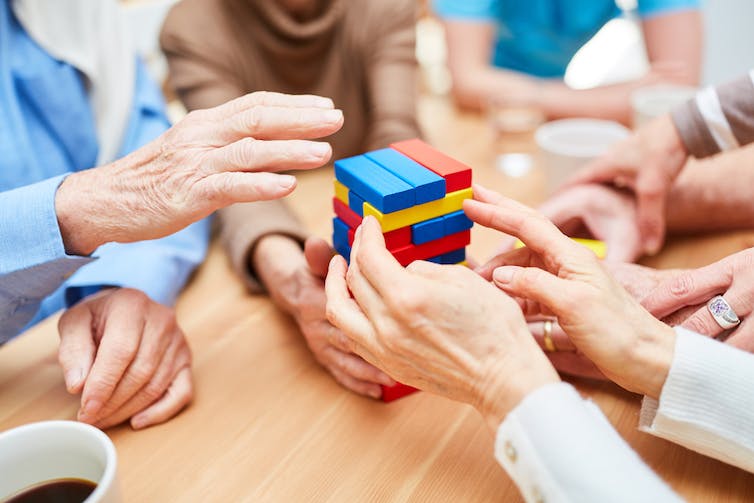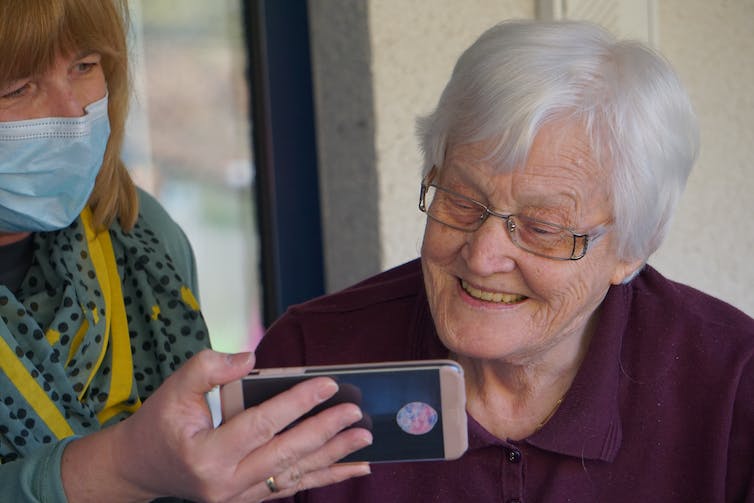Photograph by cottonbro/Pexels, CC BY
What’s the day by day routine like for older folks in residential aged care amenities?
To search out out, we spent 312 hours observing 39 residents at six Australian aged care amenities to learn the way and the place they spend their time throughout the day. We wished to understand how socially engaged residents really had been and the way this might have an effect on their wellbeing.
Our research, printed within the journal PLOS One, highlights some long-standing points in aged care but additionally gives promise.
Residents had been largely energetic, each by way of speaking with different folks within the centre and by way of doing actions. However there’s extra we will do to create alternatives for socialising.

There’s extra we will do to create alternatives for socialising in residential aged care.
Shutterstock
Learn extra:
Abroad recruitment will not clear up Australia’s aged care employee disaster
People are a social species
Transitioning from life at dwelling to life in aged care might be difficult, typically linked with lack of independence, lack of id, and lack of management.
Many additionally affiliate transferring into aged care with a decline of their social lives and total bodily well being.
So it’s no shock folks dwelling in aged care houses undergo from typically low ranges of wellbeing.
Earlier analysis has discovered residents hardly attend actions of their facility. The conversations they do have are sometimes with care employees – these are very uncommon, quick, and primarily about their bodily care.
Nonetheless, earlier research typically fail to seize essential features of how and the place socialisation happens in aged care.
We all know people are a social creatures and that we’re wired to attach, with extra social connections boosting our total wellbeing.
That’s why we determined to take a better take a look at how aged care residents spend their time.

Having good proof on how folks spend their time in aged care centres helps establish gaps so we will tackle them.
Photograph by Georg Arthur Pflueger on Unsplash, CC BY
What we discovered
In the course of the 312 hours we spent observing 39 residents, we discovered a day within the lifetime of a resident seems one thing like this:
waking up within the morning and preparing for the day (with the assistance of private care employees if crucial)
attending the eating room for breakfast and spending a lot of the morning within the frequent space or lounge room – maybe taking part in an exercise run by the approach to life employees on the facility – earlier than returning to the eating room for lunch
after that, relying on whether or not there may be an exercise being organised, most will return to their very own rooms to recuperate earlier than coming again to the eating room for dinner within the early night.
We discovered social interactions peak at breakfast, lunch and dinner.
Throughout the day, residents
spent the best proportion of time (45%) in their very own room
had been alone 47.9% of the time
had been inactive 25.6% of the time
had been most certainly to talk with different residents, adopted by employees, then household
exterior of meal occasions, residents had conversations within the frequent space or in their very own rooms.
General, residents spent greater than half their time being socially and bodily energetic.
Over a 3rd of their time was spent with one other resident. Spending time with different residents was most certainly to be related to a better high quality of life.
We additionally discovered spending time with employees or an excessive amount of time alone was linked to poorer high quality of life.

Spending time with different aged care residents tends to be related to a better high quality of life.
Photograph by Singapore Inventory Pictures on Unsplash, CC BY
Creating alternatives for socially energetic lives
Primarily based on our analysis, listed here are three issues aged care suppliers and governments can do to enhance older Australians’ wellbeing:
1. Enhance staffing
Employees shortages and time pressures are key the reason why residents spend little time with employees.
Together with extra actions chosen and assisted by residents in aged care amenities might assist create new social alternatives between residents and strengthen current ones.
2. Tailor Montessori packages to the aged care atmosphere
Montessori packages create a collaborative strategy full of self-directed actions with hands-on studying and play. Actions embody issues like sorting and recognising objects, finishing puzzles, and practising opening locks.
Montessori packages in small teams or led by members of the family would swimsuit the smaller employees to resident ratios in lots of aged care centres. They’d additionally assist residents (together with these with dementia) regain some independence, really feel much less bored or remoted and have a way of function.
3. Change the bodily atmosphere and provide extra afternoon actions
Altering the bodily atmosphere to accommodate for extra social areas would go a great distance to assist.
Rising the variety of actions within the afternoon would imply residents have extra alternatives to socialize with one another, particularly those that are busy with private care routines within the mornings.
Doing residential aged care otherwise
After media stories and a royal fee highlighted the failings of Australia’s aged care system, it’s time to assume otherwise about aged care.
Our research reveals residents can and do socialise, and that it may considerably enhance folks’s high quality of life.
We should now discover methods to vary aged care environments and practices to create extra social alternatives.
Learn extra:
Complaints, lacking individuals, assaults – contracting exterior staff in aged care will increase issues

Joyce Siette is affiliated with the Australian Affiliation of Gerontology.
Laura Dodds receives funding from Macquarie College.













